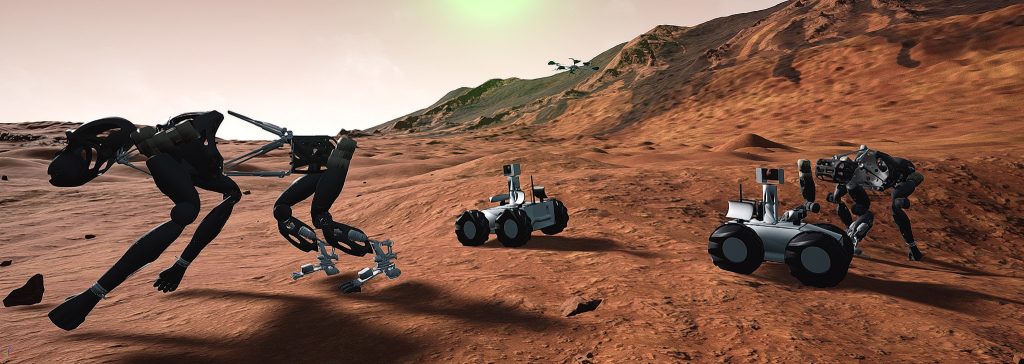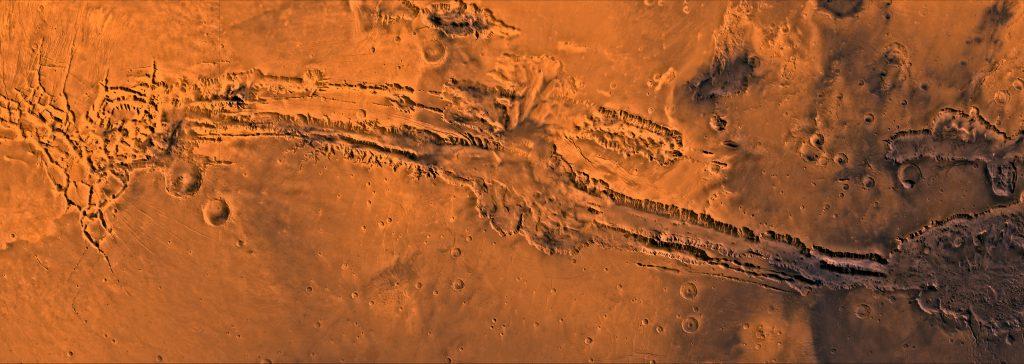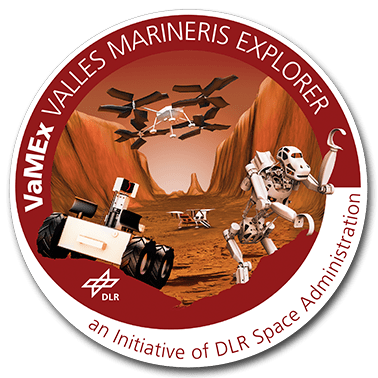Valles Marineris Explorer (VaMEx)
The goal of the VaMEx project is to explore and search for forms of non-terrestrial life of the Valles Marineris using an autonomous drone swarm consisting of rovers, crawlers and unmanned aerial vehicles (UAVs). Check out a video demonstrating some key aspects of the project on YouTube.

The project started in its first stage of development in spring 2012, where key technologies for the realization of a future space mission were to be developed, in which different types of drones would work together cooperatively. One focus topic in particular was the autonomous navigation capability of the swarm drones. In 2015, after the successful completion of the pioneer project, a second development phase followed with several additional collaborative projects that focused specifically on certain technology carriers in parallel. In the same year, the VaMEx initiative of DLR Space Management was created, which is a project line with the goal of demonstrating and providing all key technologies required for the VaMEx space mission scenario. In 2017/18, the SKAD Phase 0 investigation was performed on behalf of DLR Space Management, considering a terrestrial VaMEx demonstration mission with satellite support. The results developed and available so far now form a sound basis for formulating such a terrestrial demonstration mission for the first time as the goal of a third and, for the time being, final development phase.
This third development phase started at the end of 2022 under the name VaMEx-3, in which the swarm is considered as a whole for the first time and its capability of a cooperative, autonomous exploration is fully developed. The goal of VaMEx-3 is to carry out all developments and preparations for a demonstration mission on Earth in order to sustainably recommend itself as a payload for a Mars mission by 2025
Search for extraterrestrial life
One of the most important questions, if not the central question, that accompanies space exploration is the question of life. This question divides into two foci: Does life exist apart from the terrestrial life we know? Can terrestrial life forms survive on other celestial bodies? In addition to the icy moons Europa and Enceladus, our neighboring planet Mars is in focus in the search for past or present extraterrestrial life or potential habitat for terrestrial life forms.

The surface of Mars is extremely hostile to life, but there are niches on Mars where life may exist. Investigations in hostile regions such as the dry valleys in Antarctica showed that even there life exists in certain areas such as fissures in rocks. The life there develops on certain minerals, uses small temperature differences, places with increased relative humidity and small amounts of liquid water, which they obtain either through the soil or from the atmosphere in the form of water vapor. If we start from the terrestrial life forms we know, the availability of water is a crucial parameter for potential habitats on Mars. This is particularly related to the geological, soil chemical, and atmospheric conditions of a locality. Previous research provides evidence that these conditions may be met in Valles Marineris on Mars.
For this reason, exploration of Valles Marineris on Mars is being planned and developed in the VaMEx project and is expected to be accomplished in the future using a heterogeneous, autonomous robot swarm.
Valles Marineris
Valles Marineris on Mars is one of the largest rift valley systems in our solar system, with a width of 700 km, a length of 4000 km, and a depth of up to 10 km.

Due to indications of water deposits, former volcanic activity and shading from UV radiation, the rift valley system is particularly exciting, as it provides the conditions for the existence of extraterrestrial life. On the surface of Mars, the atmospheric pressure is 6 mbar, which corresponds to the triple point of water. At the bottom of the trench, however, there is an atmospheric pressure of 13 mbar, which means that water could exist in the liquid state. In the slopes of the rift valley, cooled basaltic, thin-bodied lava was discovered with the help of the Mars Express spacecraft. In addition, it was shown that the rocks had also undergone mineralogical changes due to the influence of water flowing in large quantities through the valleys and further deepening the trench. Other indications of possible habitats are regularly occurring mists of water vapor and seasonally recurring slope lines, which according to some researchers are probably caused by liquid water (salt solutions).
The Valles Marineris thus place high navigational demands on the robotic swarm, consisting of moving, running as well as flying systems. Therefore, it is necessary to develop and validate systems and procedures that perform the resulting mapping task autonomously, fault-tolerantly, and with sensors and algorithms that are optimal for the Martian surface.
